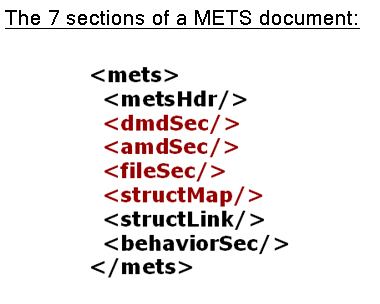 | ||
The Metadata Encoding and Transmission Standard (METS) is a metadata standard for encoding descriptive, administrative, and structural metadata regarding objects within a digital library, expressed using the XML schema language of the World Wide Web Consortium (W3C). The standard is maintained as part of the MARC standards of the Library of Congress, and is being developed as an initiative of the Digital Library Federation (DLF).
Contents
Introduction
METS is an XML Schema designed for the purpose of:
Depending on its use, a METS document could be used in the role of Submission Information Package (SIP), Archival Information Package (AIP), or Dissemination Information Package (DIP) within the Open Archival Information System (OAIS) Reference Model.
Digital libraries Vs Traditional libraries
Maintaining a library of digital objects requires maintaining metadata about those objects. The metadata necessary for successful management and use of digital objects is both more extensive than and different from the metadata used for managing collections of printed works and other physical materials. METS is intended to promote the preservation of, and interoperability between digital libraries.
Flexibility and Interoperability
The open flexibility of METS means that there is not a prescribed vocabulary which allows many different types of institutions, with many different document types, to utilize METS. The customization of METS makes it highly functional internally, but creates limitations for interoperability. Interoperability becomes difficult when the exporting and importing institutions have used vocabularies. As a workaround for this problem the creation of institutional profiles has become popular. These profiles document the implementation of METS specific to that institution helping to map content in order for exchanged METS documents to be more usable across institutions.
History
As early as 1996 the University of California, Berkeley began working toward the development of a system that combined encoding for an outline of a digital object's structure with metadata for that object. In 1998 this work was expanded upon by the Making of America II project (MoAII). An important objective of this project was the creation of a standard for digital objects that would include defined metadata for the descriptive, administrative, and structural aspects of a digital object. A type of structural and metadata encoding system using an XML Document Type Definition (DTD) was the result of these efforts. The MoAII DTD was limited in that it did not provide flexibility in which metadata terms could be used for the elements in the descriptive, administrative, and structural metadata portions of the object. In 2001, a new version of the DTD was developed that used namespaces separate from the system rather than the vocabulary of the previous DTD. This revision was the foundation for the current METS schema, officially named in April of that year.
Characteristics
Any METS document has the following features:
The 7 sections of a METS document
METS profiles
A profile is expressed as an XML document. There is a schema for this purpose. The profile expresses the requirements that a METS document must satisfy. A sufficiently explicit METS Profile may be considered a data standard.
